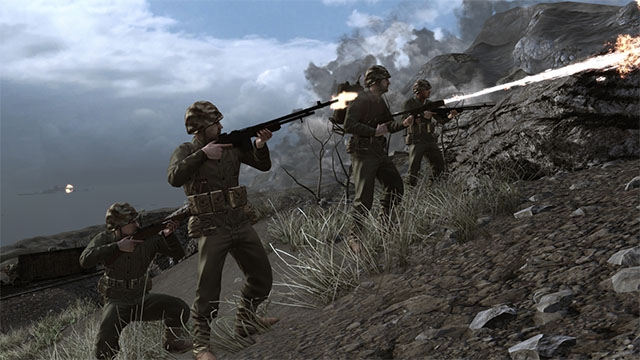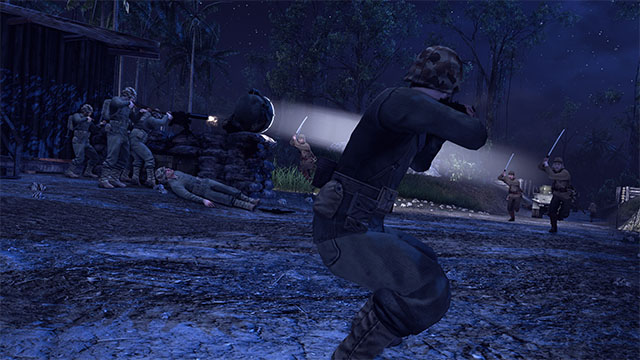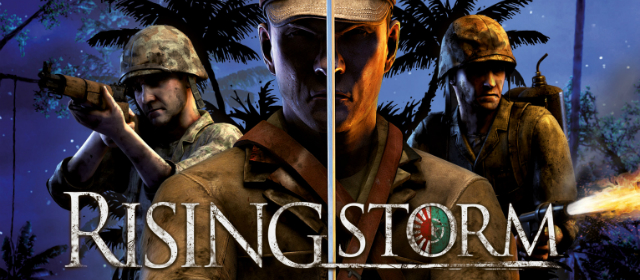The bullet is a terrifying thing. One dum dum may be barely more than three inches long but the rate at which the things are launched from a weapon, and the deadly force carried with them, more than makes up for their tiddly size. Be honest, if you knew even one was streaking towards you, the chances are you’d hide, cower, wince, shrivel up, whimper and resort to any other form of panicking reaction you may have. Yet for all the games that revolve around bullets it’s rare that a title tries to convey the terror of the armament rather than adhering to the typical shooter sensibilities that remain rooted in adolescent BB gun led day dreams.
This is the Red Orchestra series’ defining point: bullets are terrifying. This is achieved through two key elements. Death comes quick in Red Orchestra, even in the apparently novice slanted ‘Action’ mode, and even if a wound isn’t fatal it will demand bandage application to avoid blood loss, an effect that makes you feel every hit. Alongside this is the concept of decayed concentration and morale when under a hail of lead. Should bullets be flying nearby, your vision will start to distort in an attempt to simulate the psychological pressure of staring death in the face.
These two elements combine to create an extremely measured online first person shooter that’s all about using cover spots, careful blind fire (proper blind fire at that, this is a first person game at all times) and only moving when you know it’s safe to do so. Despite similarities in scope to the likes of Battlefield it really is worlds apart, and those two notes above are but a mere smidgen of the ways that Red Orchestra 2 and its standalone sort-of-sequel-sort-of-expansion – Rising Sun – works to create a more tangible, sickening simulation of the theatre of war. Realistic First Person Tank driving anyone?

If you’ve played Red Orchestra 2 then I apologise for traipsing over old ground but it’s an important paradigm to reiterate whenever you’re trying to talk about this franchise; not everyone realises exactly what sets it apart. What sets Rising Storm apart from its predecessor? Simple; Red Orchestra 2 focused on the European battles while Rising Storm is more interested in the Pacific plight of the Allies versus the Japanese. While Red Orchestra 2 was all trench littered fields, tight buildings and snow, Rising Storm’s open plains are instead cluttered with intimidating vegetation, its villages mere fishing towns built of twigs and bamboo, and its weather more inclined to burning sun.
While it’s hard to argue Rising Storm’s stance as a standalone sequel, the change of setting alters more than you might imagine. Not least thanks to the American’s sickening Flamethrower and the Japanese army’s morale shattering banzai charge; two immense differences that pronounce the army’s unique strategies further than the original Red Orchestra 2’s sides were able to.
The vegetation was the biggest change for myself during a recent stint with the beta. Set during the Guadalcanal campaign – more accurately, it portrays the Midnight Raid on Guadalcanal – the combat is overseen by a grim night sky while search lights blaze into the air and players leer through leaf and branch to try and spot movement before they’re targeted themselves. During the war for the first two capture points (the game is played in an attack and defence style) the Americans can easily dig in at the front line of a nearby fishing village and the attacking Japanese forces have little, bar a line of palm trees and gigantic leaves, to use as camouflage for their advance.
So, there me and another chap were, we could hear our Japanese brothers charging the American lines, being mowed down brutally in the slightly open gap between our tree cover and their fence line. Frequent blind fire from the Americans meant that it was hard for our boys to move forward due to the blurring effects of crippled morale. We were locked down. Me and another soldier decided that this stalemate wasn’t pleasant and started to move to the right side. Tree to tree we made careful, slow movements towards an unguarded entrance to the enemy camp praying, with each movement, that the fence line didn’t acknowledge our plan. As my buddy ran for the cover of the enemy’s fence he was spotted by a lone soldier who, boiling with confidence, began bearing down on his position. My ally ducked at the fence rather than attempt to engage – a wise decision given the bullet that tried to follow him over his cover – and I took my aim at the advancing soldier; one shot, one kill. He didn’t think that he might have assistance waiting in the vegetation, he probably didn’t even see me.
The tale obviously continued to have us take the points and go on to win the match but it’s Rising Storm’s decision to fill a level with trees and play it out at night that stuck out to me. The intensely reduced visibility is the sort of ingredient that Rising Storm, with its incline towards realism, feels the liberty to play with, and it’s just the spice that allowed for that sort of creeping along, covering each other and trying to remain hidden style of gameplay that felt exactly like you’d expect it to feel; terrifying. It reminded me of playing hide and seek in the woods at night and, in all honesty, I was probably holding my breath while hunched over my keyboard throughout the entire thing.
Perhaps it was the choice of Guadalcanal, or the knowledge that Iwo Jima is another map in this beta, but my mind flashed back to Battlefield 1942 (and, yes, 1943) and all I could think about was how frivolous and ultimately arcade-like those experiences are in comparison, with their easy to use weapons and huge open areas. I’ve been one to triumph and trumpet the Battlefield experience over Call of Duty for a long time on the basis that Battlefield is more varied and intense but it’s like a Micro Machines Army set compared to Rising Storm (I’d kill for a Battlefield map based Night Attack! by the way). In Red Orchestra I’ve found the real Battlefield, and it all comes down to the feelings of claustrophobic pressure conveyed in its mechanics.

You see, Multiplayer games of this scope can easily become disorganised but through Red Orchestra’s myriad of systems, and the morale system in particular, the two opposing teams of players do dig in and do advance cautiously and do use the smart cover system and do play patiently. The whole thing feels more structured and real because of this, and anyone that finds online FPS games a little bit reckless and brainless needs to experience Red Orchestra 2 or, indeed, Rising Storm to see that not only can they can be better, they are better.
It’s not an exaggeration to state that while playing I frequently found myself scared and, to an extent, a little sick. The way you have to ‘check’ your ammunition by holding the reload button or how you have to aim with one button and hold your breath with another and, of course, the disorientation felt while cowering behind a downed fighter plane that’s rattling with the staccato of heavy machine gun fire. Everything in Rising Storm requires just that little extra touch of concentration and consideration which, admittedly, can feel overwhelming, but in my eyes this just makes it uniquely thrilling, and an absolutely essential online shooter.
Again, I feel like I’m not offering a lot of new info to those that know Red Orchestra 2 and I apologise. In fact to those people I say simply this; from this beta alone, Rising Storm feels like a worthy addition to the franchise. More organic battlegrounds, more varied combat settings, new armies with new weapons and new abilities, all delivered with the same agonising, intoxicating Red Orchestra ‘charm’ of the second title. Considering how much Red Orchestra 2 got right in the first place, Rising Storm’s approach of ‘more of that but in a new setting’ is exactly all it needed to be, really. The bullets are still terrifying.
[nggallery id=1503]





